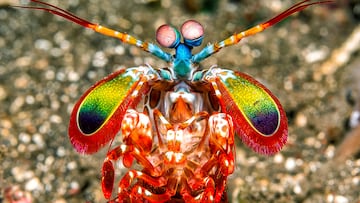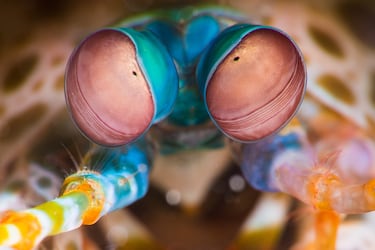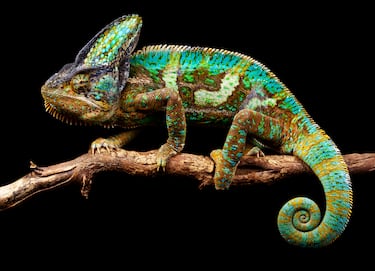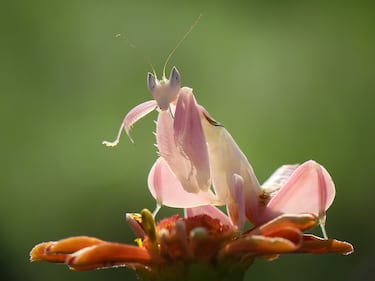How animals see the world: the hidden kaleidoscope of nature’s colors
From black-and-white vision to ultraviolet detection, discover how animals perceive colors and use them in surprising ways.

Not all animals perceive the world in color the way humans do. Evolution has equipped each species with unique visual abilities tailored to their needs, whether it’s spotting predators, hunting prey, or blending into their surroundings. Let’s delve into the fascinating spectrum of animal vision and explore the ingenious ways they use colors to survive and thrive.
The mechanics of vision: a universal evolution
Over millions of years, life on Earth has evolved sensory systems to interact with the environment. For most vertebrates, sight is the dominant sense. The ability to interpret light and color allows animals to detect movement, recognize danger, and communicate with one another.
In vertebrates, vision depends on specialized cells in the retina called photoreceptors. These include cones, which detect colors, and rods, which are sensitive to brightness. The number and type of cone cells determine how an animal perceives colors—and the differences are astounding.
Here’s a look at the different types of color vision, or lack of, across species:
These plants resemble something plucked from an alien planet. But they're actually the result of a cool trick of nature. All plants reflect an ultraviolet light that's invisible to the human eye. This is what that light looks like https://t.co/puXMz7nC2G
— WIRED (@WIRED) March 13, 2021
📸: Craig Burrows pic.twitter.com/GWLB5YLVz4
Monochromatic vision
Some animals, like salamanders, hamsters, and marine mammals such as seals, dolphins, and whales, have no color perception. With only one type of cone cell or none at all, they see the world in shades of gray, black, and white.
Dichromatic vision
Contrary to popular myths, dogs and cats do not see in black and white. With two types of cone cells, dogs can distinguish yellow and blue, while cats see blues and greens. Most mammals, including cattle and goats, are also dichromatic, perceiving yellow and blue but missing red. This explains why a bullfighter’s red cape is more about tradition than effectiveness—turquoise might grab the bull’s attention better.
Trichromatic vision
Humans, along with some primates and marsupials, have trichromatic vision, enabling them to detect the three primary colors: red, yellow, and blue. This advanced visual system allows humans to distinguish up to 10 million different shades.

Tetrachromatic vision
Birds, reptiles, and some fish have an even greater range of vision, thanks to four types of cones. They can see colors beyond human perception, including infrared and ultraviolet light. For example, snakes can detect infrared, while birds rely on ultraviolet signals to spot mates and prey.
Outside the vertebrate world, the mantis shrimp reigns supreme. With 12 types of photoreceptors, its color-detection system is so complex that scientists are still unraveling how it works.
The Purpose of Colors in Nature
Colors play an important role in Mother Nature not just the polychromatic ranges of vision but also in how animals display themselves to the world around them. Creatures large and small use a plethora of hues for varied purposes. Here’s a look.

Camouflage: the art of blending in
One of the most practical uses of color in nature is camouflage, which helps animals avoid predators or sneak up on prey. Camouflage techniques vary:
- Homochromy: Imitating the colors of the environment, like the Arctic fox, whose white winter coat blends with snow and turns brown in summer.
- Countershading: Pelagic fish, such as great white sharks, are dark on top and light on their bellies. This dual coloration helps them remain unseen from above and below.
Some animals, like chameleons, use color changes as a defense mechanism, compensating for their lack of speed or venom. Similarly, zebras’ stripes and tigers’ patterns disrupt their outlines, making it harder for predators or prey to detect them.
Warning colors: nature’s danger signs
In stark contrast to camouflage, some animals use bright, striking colors to signal danger. This phenomenon, known as aposematism, warns predators to steer clear due to toxicity or venom. Common warning colors include red, yellow, and orange, often contrasted with black.
For instance, coral snakes and wasps share vibrant warning patterns, a phenomenon called Müllerian mimicry, which reinforces their message. In Batesian mimicry, harmless species like false coral snakes and certain flies mimic dangerous ones to avoid being attacked.
Color and courtship: nature’s peacock parade
One of the most dazzling uses of color is in mating displays. Birds, in particular, are famous for their colorful feathers, with peacocks and birds-of-paradise leading the charge. Bright hues of red, purple, and orange signal health and genetic fitness, drawing the attention of potential mates.

Master of disguise for a deadly purpose: the orchid mantis
Among the masters of color in nature, the orchid mantis stands out. This remarkable insect not only camouflages itself but also mimics the appearance of a flower to lure prey. Its body perfectly replicates a blossom, a strategy so unique and effective that it’s unmatched in the animal kingdom. Truly, the orchid mantis is a lethal work of art.
Final thoughts: color, and perception of it, is as diverse as life itself
From the muted monochromatic vision of marine mammals to the kaleidoscopic world of birds and shrimp, color perception and display is as diverse as life itself. Whether used for camouflage, warning, or courtship, colors are a vital tool in nature’s arsenal, shaping how animals survive and interact with their environments.
The next time you marvel at a peacock’s feathers or a tiger’s stripes, remember: their colors are more than just beauty—they’re survival.
Original article written by A. Aparicio and P. Pallás, translated with the assistance of AI and edited by Greg Heilman.
Related stories
Get your game on! Whether you’re into NFL touchdowns, NBA buzzer-beaters, world-class soccer goals, or MLB home runs, our app has it all. Dive into live coverage, expert insights, breaking news, exclusive videos, and more – plus, stay updated on the latest in current affairs and entertainment. Download now for all-access coverage, right at your fingertips – anytime, anywhere.